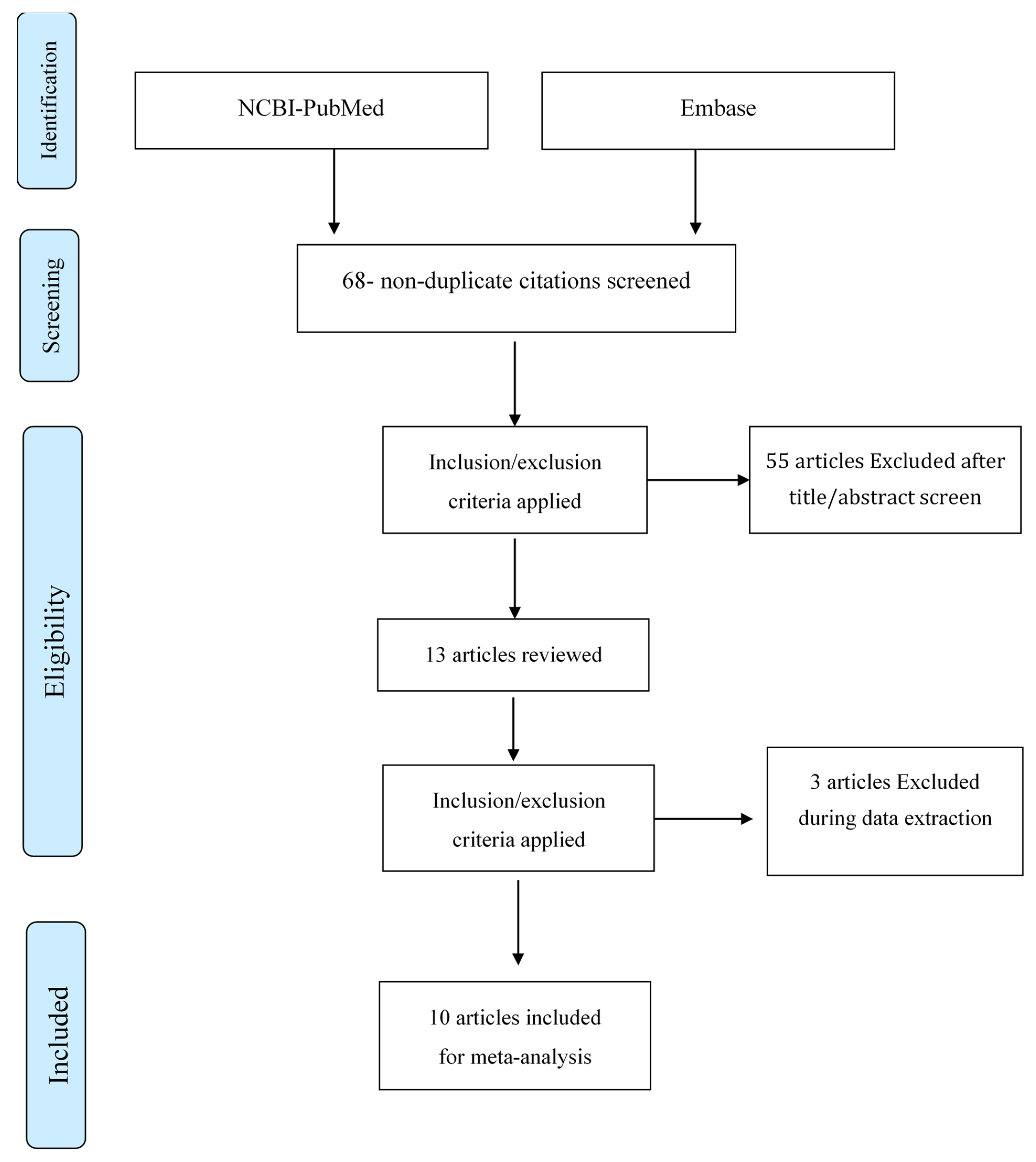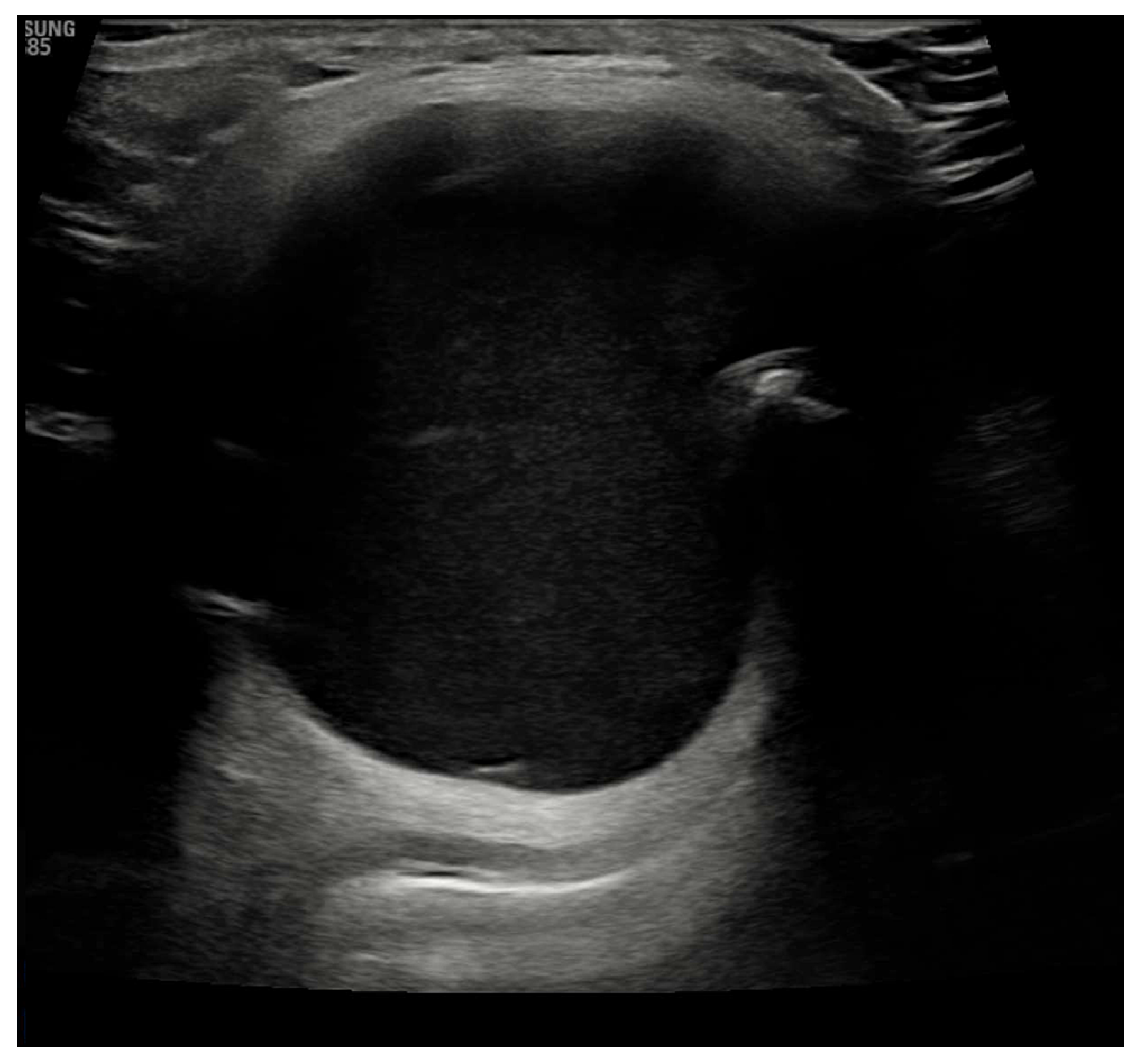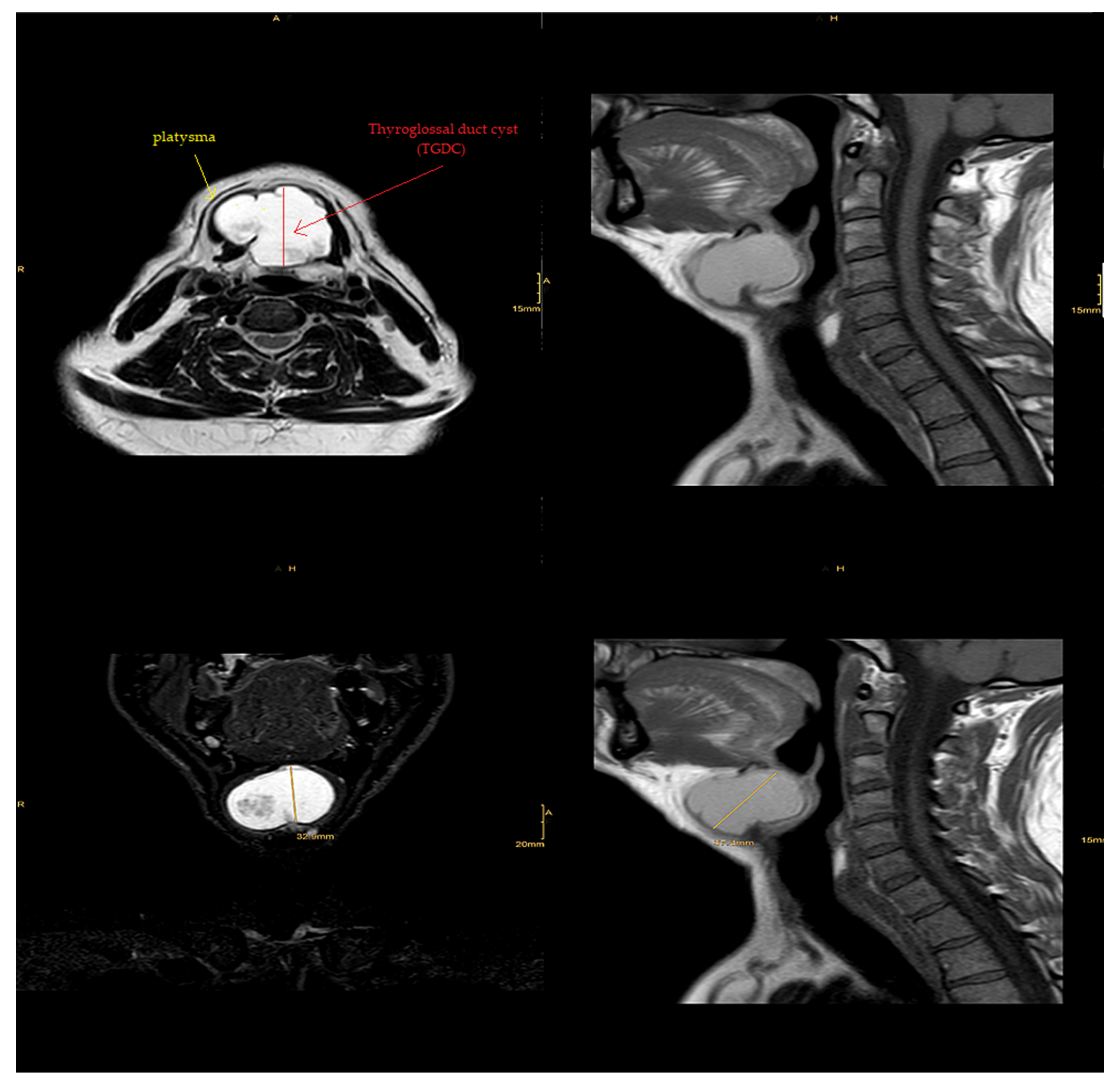Thyroglossal Duct Cyst, a Case Report and Literature Review
Abstract
:1. Introduction
2. Materials and Methods
3. Case Presentation
4. Results
5. Discussion
6. Conclusions
Author Contributions
Funding
Institutional Review Board Statement
Informed Consent Statement
Data Availability Statement
Conflicts of Interest
References
- Kurt, A.; Ortug, C.; Aydar, Y.; Ortug, G. An incidence study on thyroglossal duct cysts in adults. Saudi Med. J. 2007, 2, 593–597. [Google Scholar]
- Moorthy, S.N.; Arcot, R. Thyroglossal duct cyst-more than just an embryological remnant. Indian J. Surg. 2011, 73, 28–31. [Google Scholar] [CrossRef] [PubMed] [Green Version]
- Yang, S.-I.; Park, K.-K.; Kim, J.-H. Papillary carcinoma arising in thyroglossal duct remnant. Indian J. Surg. 2015, 6, 282–284. [Google Scholar]
- Thabet, H.A.; Nour, G.Y. Thyroglossal duct cyst: Variable presentation. Egypt. J. Ear Nose Throat Allied Sci. 2011, 12, 13–20. [Google Scholar] [CrossRef] [Green Version]
- Zander, A.D.; Smoker, W.R.K. Imaging of ectopic thyroid tissue and thyroglossal duct cysts. Radiogr. Rev. Publ. Radiol. Soc. N. Am. 2014, 34, 37–50. [Google Scholar] [CrossRef]
- Mortaja, S.; Sebeih, H.; Alobida, N.W.; Al-Qahtani, K. Large Thyroglossal Duct Cyst: A Case Report. Am. J. Case Rep. 2020, 21, e919745. [Google Scholar] [CrossRef] [Green Version]
- El-Ayman, Y.A.; Naguib, S.M.; Abdalla, W.M. Huge thyroglossal duct cyst in elderly patient: Case report. Int. J. Surg. Case Rep. 2018, 51, 415–418. [Google Scholar] [CrossRef]
- Park, M.J.; Shin, H.S.; Choi, D.S.; Choi, H.Y.; Choi, H.C.; Lee, S.M.; Jang, J.H.; Lee, J.H.; Park, J.J.; Park, S.E. A rare case of thyroglossal duct cyst extending to the sublingual space: A case report. Medicine 2020, 99, e19389. [Google Scholar] [CrossRef]
- Korbi, A.E.; Bouatay, R.; Houas, J.; Ameur, K.B.; Harrathi, K.; Koubaa, J. A rare location of thyroglossal duct cyst in a newborn. Pan Afr. Med. J. 2018, 31, 104. [Google Scholar] [CrossRef]
- Booth, R.; Tilak, A.M.; Mukherjee, S.; Daniero, J. Thyroglossal duct cyst masquerading as a laryngocele. BMJ Case Rep. 2019, 12, e228319. [Google Scholar] [CrossRef]
- Fang, N.; Angula, L.N.; Cui, Y.; Wang, X. Large thyroglossal duct cyst of the neck mimicking cervical cystic lymphangioma in a neonate: A case report. J. Int. Med. Res. 2019, 49, 300060521999765. [Google Scholar] [CrossRef] [PubMed]
- Abebe, E.; Megersa, A.; Abebe, K. Huge thyroglossal duct cyst at the supra-sternal notch. J. Surg. Case Rep. 2019, 4, rjz112. [Google Scholar] [CrossRef]
- Kerr, J.; Niermeyer, W.L.; Baker, P.B.; Chiang, T. Floor of mouth thyroglossal duct cyst: A rare embryologic course. J. Surg. Case Rep. 2019, 11, rjz303. [Google Scholar] [CrossRef] [PubMed]
- Ogunkeyede, S.A.; Ogundoyin, O.O. Management outcome of thyroglossal cyst in a tertiary health center in Southwest Nigeria. Pan Afr. Med. J. 2019, 34, 154. [Google Scholar] [CrossRef]
- Leach, L.; Jonas, N. A rare case of a lingual mass in a neonate. J. Surg. Case Rep. 2018, 4, rjy059. [Google Scholar] [CrossRef] [PubMed] [Green Version]
- Vrinceanu, D.; Dumitru, M.; Cergan, R.; Anghel, A.G.; Costache, A.; Patrascu, E.T.; Sarafoleanu, C.C. Correlations between ultrasonography performed by the ENT specialist and pathologic findings in the management of three cases with thyroglossal duct cyst. Med. Ultrason. 2018, 20, 524–526. [Google Scholar] [CrossRef] [PubMed] [Green Version]
- Chang, K.V.; Wu, W.T.; Özçakar, L. Thyroglossal duct cyst: Dynamic ultrasound evaluation and sonoanatomy revisited. Med. Ultrason. 2019, 21, 99–100. [Google Scholar] [CrossRef] [PubMed]
- Aytaç, I.; Tunç, O. Thyroglossal Duct Cysts: A Clinico-Surgical Experience of 100 Cases. Eur. J. Ther. 2021, 54, 13–15. [Google Scholar]
- Júnior, G.D.L.B.; Silva, L.D.F.; Pimentel, G.G.; Filho, J.R.L.; Nogueira, R.L.M. Treatment of Large Thyroglossal Duct Cyst. J. Craniofacial Surg. 2017, 28, e794–e795. [Google Scholar] [CrossRef]
- Sarmento, D.J.d.; Araújo, P.P.T.; da Silveira, É.J.D.; Germano, A.R. Double thyroglossal duct cyst involving the floor of the mouth and sublingual gland region. J. Craniofacial Surg. 2013, 24, e116–e119. [Google Scholar] [CrossRef]
- Mukul, S.; Kumar, A.; Mokhtar, E. Sublingual thyroglossal duct cyst (SLTGDC): An unusual location. J. Pediatric Surg. Case 2016, 10, 3–6. [Google Scholar] [CrossRef] [Green Version]
- Liu, T.P.; Jeng, K.S.; Yang, T.L. Thyroglossal duct cyst: An analysis of 92 cases. Zhonghuayixuezazhi Chin. Med. J. 1992, 49, 72–75. [Google Scholar]
- Waddell, A.; Saleh, H.; Robertson, N. Thyroglossal duct remnants. J. Laryngol. Otol. 2000, 114, 128–129. [Google Scholar] [CrossRef] [PubMed]
- Soni, S.; Poorey, V.K.; Chouksey, S. Thyroglossal Duct Cyst, Variation in Presentation, Our Experience. Indian J. Otolaryngol. Head Neck Surg. 2014, 66, 398–400. [Google Scholar] [CrossRef] [Green Version]



| Factors | Frequency | |
|---|---|---|
| Age (years) | ≤10 | 30 (63.8%) |
| 11–20 | 9 (19.1%) | |
| 21–30 | 2 (4.3%) | |
| 31–40 | 1 (2.1%) | |
| 41–50 | 2 (4.3%) | |
| 51–60 | 2 (4.3%) | |
| 81–90 | 1 (2.1%) | |
| Sex | Male | 25 (53.1%) |
| Female | 21 (44.7%) | |
| Unknown | 1 (2.1%) | |
| Site of the cyst | Infrahyoid | 33 (70.2%) |
| Suprahyoid | 12 (25.5%) | |
| Intralingual | 2 (4.3%) | |
Publisher’s Note: MDPI stays neutral with regard to jurisdictional claims in published maps and institutional affiliations. |
© 2022 by the authors. Licensee MDPI, Basel, Switzerland. This article is an open access article distributed under the terms and conditions of the Creative Commons Attribution (CC BY) license (https://creativecommons.org/licenses/by/4.0/).
Share and Cite
Taha, A.; Enodien, B.; Frey, D.M.; Taha-Mehlitz, S. Thyroglossal Duct Cyst, a Case Report and Literature Review. Diseases 2022, 10, 7. https://doi.org/10.3390/diseases10010007
Taha A, Enodien B, Frey DM, Taha-Mehlitz S. Thyroglossal Duct Cyst, a Case Report and Literature Review. Diseases. 2022; 10(1):7. https://doi.org/10.3390/diseases10010007
Chicago/Turabian StyleTaha, Anas, Bassey Enodien, Daniel M. Frey, and Stephanie Taha-Mehlitz. 2022. "Thyroglossal Duct Cyst, a Case Report and Literature Review" Diseases 10, no. 1: 7. https://doi.org/10.3390/diseases10010007
APA StyleTaha, A., Enodien, B., Frey, D. M., & Taha-Mehlitz, S. (2022). Thyroglossal Duct Cyst, a Case Report and Literature Review. Diseases, 10(1), 7. https://doi.org/10.3390/diseases10010007






